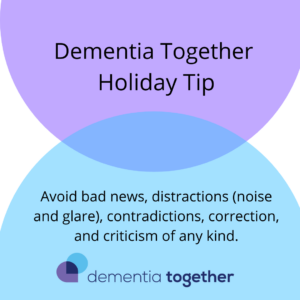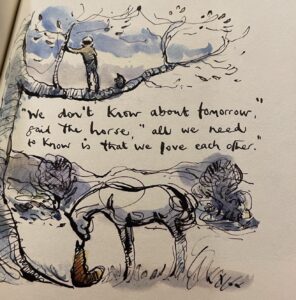11 Dec Making Your Visits Count during the Holidays
Making your visits count: Tips for family members visiting loved persons in a long-term care communities living with dementia.
How can you as a family member create joyful feelings that will linger for your loved person even when the facts of the visit may not be recalled? We at Dementia Together hope these visit tips help answer that question and give you ideas for investing in joyful moments that matter.
- If your loved one is earlier in the dementia progression and looking forward to your visit, it may be helpful to announce who you are. (example: “Hi Grandma, it’s Anna.” “Hi Dad, it’s your daughter, Sarah.”)
- Approach from the front. (It’s sometimes fine to start speaking before being seen if your voice is likely to be more familiar than your appearance.)
- Catch eye contact if possible so you can sense your loved person’s readiness for a visit.
- If masks are required, wear a clear mask if possible so that your loved person can see your face. (Ask the care community to provide you with one that is FDA approved if you are unable to order one yourself. Dementia Together has a few on hand and several Northern Colorado care communities are supplying them for families and staff.) https://www.theclearmask.com/
- If the environment allows and a visit is likely to feel foreign to your loved person’s daily routine, consider the Contented Dementia technique (SPECAL ® Method) of fading in and out: Simply and subtly “parachute” into the surroundings, letting your loved person notice you casually sitting in the chair, looking at pictures or a book they might find interesting, or even singing or humming their favorite song. Invite your loved person to join you (while still adhering to care community guidelines.)
- Speak clearly, slowly, and naturally with a calm, upbeat tone. Smile and maintain eye contact. You are a mirror reflecting to your loved person, “you have something to worry about” or “all is well.” Your loved person will sponge off the mood you project.
- Avoid bad news, distractions (noise and glare), contradictions, correction, and criticism of any kind. If in doubt about whether or not to share information, ask yourself, “for whose benefit am I sharing this?” If your loved one may not be able to process the information without trauma, consider their well-being above all and choose to humbly consider how their feelings will store well even if the facts of what you share may not be recalled. Choose topics that will promote joy and contentment.

- Avoid asking direct questions, especially those requiring retention of recent facts, since questions may make your loved person feel “put on the spot” to come up with an answer. Even the question: “How are you?” requires your loved one to access information they may or may not have related to who is asking that question. Instead, make statements: “It’s so good to see you.” “You’re looking well.”
- Talk about one thing at a time. Move onto to a different topic/activity if your loved one seems disinterested or if they start talking about something else.
- Talk about their area of interest and expertise, using familiar words and favorite old stories to make it easier for them to engage in conversation.
- When your loved person starts speaking, just listen with pleasant, interested curiosity without interrupting, contradicting, or correcting.
- Use nonverbal cues and gestures.
- Consider bringing a prop – something of meaning that your loved person may want to hold to spark conversation and engagement. If pets are allowed, don’t miss the opportunity to bring them if able.
- Bring a couple enlarged pictures to prompt reminiscing (without quizzing) from early years of your loved person’s life: “Hey Dad, I found this picture of you, your brother, and your dad after quite a day of hunting!…you all look happy!”
- Have a few favorite songs downloaded or bring a portable player with their favorite music ready to play, “I ran across this song and wanted to share it…” Sing together (ahead of the visit, write down the names and lyrics of songs you could sing together, so you don’t waste precious time during the visit trying to think of a song your loved person would like.)
- If historically important to your loved one, read scripture or poetry out loud to/with them. Pray with them.
- Listen for the messages behind their words, responding to their feelings.
- If your loved one will be at a family gathering or amidst a crowd of people, ensure that ONE person is assigned to be in a ‘we-relationship’ (SPECAL ® Method) ready with eye contact and a smile.
- Upon creating a ‘we-relationship’ with your loved one, be the one to offer a clue. Do this as a companion, not an instructor, offering narrative about what “we’re” doing or what “we’re” doing next.
- Leave on a positive note (feelings linger even if facts are not stored).
- If your loved person becomes engaged with someone else, consider again the Contented Dementia technique (SPECAL ® Method) of fading in and out: “evaporating” into the background as you leave rather than interrupting your loved person’s moment of well-being by insisting on a “goodbye.” You can determine if this is a beneficial approach by assessing whether your goodbye would leave your person with the sense of loss and feeling of grief without them likely able to recall the facts of knowing why they feel sad. If your loved one is enjoying the moment and content with another companion or activity at the time of your arrival or departure, it may be kinder to fade in and out with your visits.
The limited visits may never feel like enough time, but if you have shared a moment of joy, contentment, and connection, you have made your loved person’s life better. As our pocket cards for people living with dementia state, “Even if I don’t recognize your name or your face, I will always recognize beauty, kindness, and love.” Our privilege in caring for someone living with dementia is that we get to be the providers of beauty, kindness, and love. Is there a higher honor?
“Just because facts aren’t recalled doesn’t mean moments aren’t significant.”
Cyndy Hunt Luzinski, MS, RN, Founder and Executive Director
Pictures and Quotes from: Mackesy, Charlie. The Boy, the Mole, the Fox and the Horse New York, NY: HarperOne, 2019.


